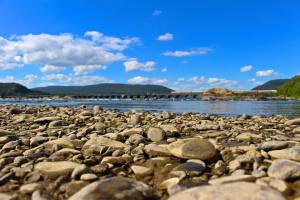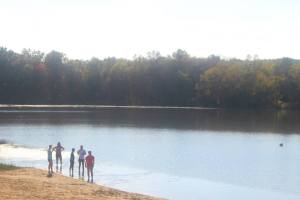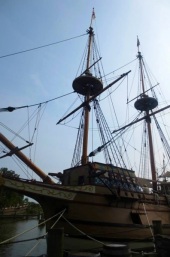Throughout our travels around the Chesapeake, the relationship between environment and society has been well depicted. It is apparent that our society is very fragile in a sense because a society is dependent on factors that are constantly changing. A seemingly small change in the environment can affect our society immensely. Because of this fragile relationship, our environment often dictates what we can and cannot do as a society and can force us to comply with its constraints. Simply stated, we are shaped by our environment. But there is another side to the relationship. As a society, we are able to shape the environment we live in. Does one have a stronger effect on the other? An interesting contrast of the relationship between environment and society was unmistakable with our visits to Jamestown, Annapolis, and Baltimore. Using these three experiences from our first journey, one can compare the progression of this relationship in different locations as we move forward through history.
Visiting Jamestown, it became easy to understand just how large of an effect the environment had on the settlers in the early seventeenth century. The colonists of Jamestown had to comply with their environment the minute they entered the James River in 1607. A drought restricted their agriculture, the river water was too saline to drink and this new environment was laden with disease unfamiliar to the Englishmen. All of these constraints lead to a steep decline in the population of the colony. Most of the major causes of this decline were environmental. What is interesting is that these colonists were fairly intelligent Englishmen who were very capable of surviving within their environment in Europe. One problem was that they were so well adapted to one specific environment and when that environment was changed they suddenly became unfit to live under these new constraints. The environmental limitations in this new colony were too great and the colonists were forced to change aspects of their society. As we learned at the archeological site in Jamestown, a fairly civil group of people turn to cannibalism and their society alters into a society of survival. The remains of a young woman were excavated at the site of Jamestown and confirm the beliefs that these settlers did resort to cannibalism. The history of Jamestown solidifies the idea that the environment can have a large impact on the workings of a society.
As we travel one hundred miles up the bay and one hundred years later in history, we arrive in Annapolis in the eighteenth century. This environment was very well suited for tobacco and so it drove a society operated essentially through the use of slave power. The men of Annapolis, with a need for labor, acquired slaves to work their tobacco fields and throughout the eighteenth century they accrued wealth, built large Georgian houses and imported more slaves. While visiting the Maryland State Archives, it was brought to our attention, just how many slaves there were in this time period but also how valuable they were to their masters. The masters of the runaway slaves would take ads out in the Maryland Gazette and offer rewards to those who found or returned their slave. In 1695 three thousand African Americans were imported to the Chesapeake region and all because of this environmental asset. It seems odd to think that the introduction of slaves into the Chesapeake region was all because of good soil for tobacco, but if the Chesapeake had depleted soil, would Englishmen had settled in this area in the first place? Whatever the answer may be, one cannot deny this link between the supreme environmental conditions and the building of a society with the use of slave labor.
Our visit to the Baltimore Museum of Industry brought us into the industrialized nineteenth century. In this place and time it is evident that the society is affecting the environment more so than the converse. The society was demanding oysters and with the introduction of refrigeration, the oyster market is larger than ever. The environment is clearly affected. Aside from the canneries, there were many other factories often coal burning ones. Air quality was noticeably worsened throughout this time period and there was so much particulate matter in the air that the fabric factories would have to keep their windows closed as to not ruin the clothing that was being produced. Many wealthier families refused to live inside the city because of the smell and the waste from the factories. A few hundred years earlier men were dying because of the effects of the environment. In the nineteenth century it is the opposite. The environment is dying, in a sense, because of the effects of man.
Over time, it seems as if we have a stronger effect on our environment than our environment has on us. We have the ability to manipulate the environment in ways we could not three hundred years ago. Today, we have become comfortable with our way of living and this way of living is not beneficial in the long run. As a society, we have been dealing with the repercussions of our previous generations when we could have been monitoring how we interact with our environment. One may think that we have these issues because we view our environment with only instrumental value. We see our environment for what it can produce and how it can help us make money. It might be beneficial to start looking at our environment with intrinsic value. Then maybe the relationship between environment and society could be balanced.





